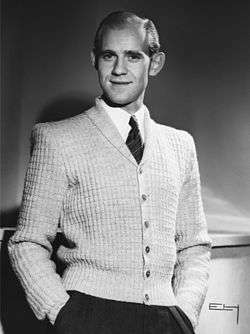Cardigan (sweater)
A cardigan is a type of knitted garment that has an open front.[1]
 Cardigan in fashion photo from 1947 | |
| Type | Knitted garment |
|---|---|
| Material | Many |
| Manufacturer | Many |


Description
Commonly cardigans have buttons: garments that are tied are instead considered a robe. A more modern version of the garment has no buttons and hangs open by design. By contrast, a pullover (or sweater) does not open in front but must be "pulled over" the head to be worn. It may be machine- or hand-knitted. Traditionally, cardigans were made of wool but can now be made of cotton, synthetic fibers, or any combination thereof.
History
The cardigan was named after James Brudenell, 7th Earl of Cardigan, a British Army Major General who led the Charge of the Light Brigade at the Battle of Balaclava during the Crimean War.[2] It is modelled after the knitted wool waistcoat that British officers supposedly wore during the war. The legend of the event and the fame that Lord Cardigan achieved after the war led to the rise of the garment's popularity – supposedly, Brudenell invented the cardigan after noticing that the tails of his coat had accidentally been burnt off in a fireplace.[3][4] The name "Cardigan" is an anglicised variation of the Welsh placename Ceredigion.
The term originally referred only to a knitted sleeveless vest, but expanded to other types of garment over time. Coco Chanel is credited with popularizing cardigans for women because "she hated how tight-necked men's sweaters messed up her hair when she pulled them over her head."[5] The garment is mostly associated with the college culture of the Roaring Twenties and early 1930s, being also popular throughout the 1950s, the 1970s and the 1990s. Cardigans have also regained popularity during the 2010s.
Usage
Plain cardigans are often worn over shirts and inside suit jackets as a less formal version of the waistcoat or vest that restrains the necktie when the jacket has been removed. Its versatility means it can be worn in casual or formal settings and in any season, but it is most popular during cool weather.
Monochromatic cardigans, in sleeved or vest form, may be viewed as a conservative fashion staple. As an item of formal clothing for any gender, it is worn over a button-down dress shirt. A less formal style is wearing a T-shirt underneath.
In popular culture
- Singer Perry Como wore cardigans on the television program The Perry Como Show. The trademark sweaters complemented his easy-going style of singing.[6][7][8]
- Fred Rogers, star of the long-running children's program Mister Rogers' Neighborhood, donned a cardigan at the beginning of each episode. The cardigans were made by his mother and closed with a zipper instead of buttons.[9]
- Kurt Cobain of the band Nirvana wore vintage cardigans. The sweater he wore during MTV's Nirvana Unplugged concert sold at auction for $137,500 in November 2015. It was reported to have a burn hole, a button missing, and discoloration around the pockets.[10][11]
See also
References
- "cardigan". Merriam-Webster Online Dictionary. Retrieved 27 May 2018.
- le Zotte, Jennifer (3 October 2017). "This Bookish Sweater Has a Violent History". Racked. Retrieved 3 October 2017.
- "What is a Cardigan? - Cardigan Sweater History". CardiganSweater.com. Retrieved 10 March 2010.
- David, Saul (1997). The Homicidal Earl: The Life of Lord Cardigan. London: Little, Brown. pp. 431–436. ISBN 0316641650.
- Geller, Allison (24 June 2016). "The Military Origins of the Cardigan". The Atlantic. Retrieved 24 June 2016.
- Brooks, Tim; Marsh, Earle F., eds. (1987). The Complete Directory to Prime Time Network and Cable TV Shows. Ballantine Books. pp. 1071–1072. ISBN 0-345-49773-2. Retrieved 14 April 2010.
- Denisova, Maria. "Como, Perry". Pennsylvania Center for the Book, Pennsylvania State University. Archived from the original on 9 December 2007. Retrieved 4 April 2010.
- Philbin, Regis (18 October 1991). "DVD: The Best of Perry Como: Volume One (review)". Entertainment Weekly. Retrieved 30 April 2010.
- "NMAH – Mister Rogers' Sweater". National Museum of American History. Archived from the original on 3 July 2007. Retrieved 31 May 2007.
The red sweater, knitted by his late mother, was donated to the Smithsonian's National Museum of American History by Fred Rogers on November 20, 1984.
- Grossman, Samantha (5 November 2015).[ In 2019 it was re auctioned for $334,000.]"Kurt Cobain's Unplugged Sweater Sells for $137,500". Time. Retrieved 17 March 2016.
- Garcia, Patricia (9 November 2015). "Kurt Cobain’s MTV Unplugged Cardigan Sold for $137,500". Vogue. Retrieved 17 March 2016.
External links

